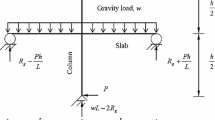Abstract
Flat slab system is becoming widely popular for multistory buildings due to its several advantages. However, the performance of flat slab buildings under earthquake loading is unsatisfactory due to their vulnerability to punching shear failure. Several national design codes provide guidelines for designing flat slab system under gravity load only. Nevertheless, flat slab buildings are also being constructed in high seismicity regions. In this paper, performance of flat slab buildings of various heights, designed for gravity load alone according to code, is evaluated under earthquake loading as per ASCE/SEI 41 methodology. Continuity of slab bottom reinforcement through column cage improves the performance of flat slab buildings to some extent, but it is observed that these flat slab systems are not adequate in high seismicity areas and need additional primary lateral load resisting systems such as shear walls. A displacement-based method is proposed to proportion shear walls as primary lateral load resisting elements to ensure satisfactory performance. The methodology is validated using design examples of flat slab buildings with various heights.
Similar content being viewed by others
References
ACI (2011), Building Code Requirements for Structural Concrete, ACI Standard 318-11, American Concrete Institute, Farmington Hills, MI.
ACI (2005), Building Code Requirements for Structural Concrete, ACI Standard 318-05, American Concrete Institute, Farmington Hills, MI.
ASCE (2014), Seismic Rehabilitation of Existing Building, ASCE/SEI Standard 41-13, American Society of Civil Engineers, Reston, VA.
Beyer K, Dazio A and Priestley MJN (2008), “Seismic Design of Torsionally Eccentric Buildings with U-Shaped RC Walls,” Instituto Universitario di Studi Superiori Press, Pavia, Italy.
BIS (1993), Indian Standard Ductile Detailing of Reinforced Concrete Structures Subjected to Seismic Forces-Code of Practice, IS 13920:1993, Bureau of Indian Standatd, New Delhi, India.
BIS (2002), Indian Standard Criteria for Earthquake Resistant Design of Structures, Part 1: General Provisions and Buildings, IS 1893 (Part 1):2002, Bureau of Indian Standatd, New Delhi, India.
BIS (2000), Indian Standard Plain and Reinforced Concrete- Code of Practice, IS 456:2000, Bureau of Indian Standatd, New Delhi, India.
CEN (2004), Eurocode 2–Design of Concrete Structures Part 1-1: General Rules and Rules for Buildings, EN-1992-1-1:2004 E, Comite Europeen de Normalization, Brussels, Belgium.
CSI (2010), SAP2000: Integrated Software for Structural Analysis & Design, Version 14.2.4-Analysis Reference Manual, Computers and Structures, Inc., Berkeley, USA.
Elwood KJ, Matamoros A, Wallace JW, Lehman D, Heintz J, Mitchell A, Moore M, Valley M, Lewoes LN, Comartin C and Mohele JP (2007), “Update to ASCE/ SEI 41 Concrete Provisions,” Web Site: http://peer. berkeley.edu/pdf/ ASCE_41_update_PEER_Report_02. pdf-report.
Fardis MN (2209), Seismic Design, Assesment and Retrofitting of Concrete Buildings, Spinger, London, UK.
Hueste MBD and Bai JW (2007), “Seismic Retrofit of a Reinforced Concrete Flat-Slab Structure: Part I–Seismic Performance Evaluation,” Engineering Structures, 29(6): 1165–1177.
Hueste MBD and Wight JK (1999), “Nonlinear Punching Shear Failure Model for Interior Slab-column Connections,” Journal of Structural Engineering, American Society of Civil Engineerings, 125(9): 997–1008.
Park YM, Han SW and Kee SH (2009), “A Modified Equivalent Frame Method for Lateral Load Analysis,” Magazine of Concrete Research, 61(5): 359–370.
Priestley MJN, Calvi GM and Kowalsky MJ (2007), Displacement-Based Seismic Design of Structures, Instituto Universitario di Studi Superiori Press, Pavia Italy.
Qian K and Li B (2013), “Experimental Study of Drop-Panel Effects on Response of Reinforced Concrete Flat Slabs after Loss of Corner Column,” ACI Structural Journal, 110(2): 319–329.
SNZ (2006), New Zealand Standard Concrete Structures Standard Part 1 - The Design of Concrete Sructure, NZS 3101:Part 1:2006, Standards New Zealand, Wellington, New Zealand.
Author information
Authors and Affiliations
Corresponding author
Rights and permissions
About this article
Cite this article
Sen, S., Singh, Y. Displacement-based seismic design of flat slab-shear wall buildings. Earthq. Eng. Eng. Vib. 15, 209–221 (2016). https://doi.org/10.1007/s11803-016-0317-1
Received:
Accepted:
Published:
Issue Date:
DOI: https://doi.org/10.1007/s11803-016-0317-1




